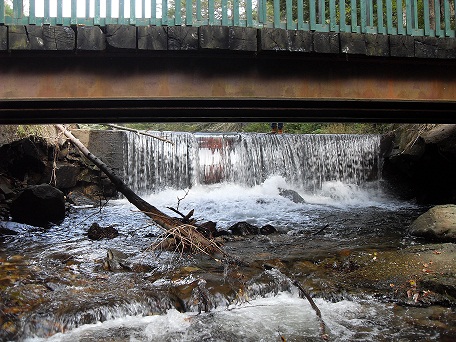CHESTER – Massachusetts Department of Fish and Game (DFG) Commissioner Mary Griffin on Friday announced the removal of Kinne Brook Dam in Chester. Continuing the Patrick administration’s commitment to protecting the Commonwealth’s natural resources, the removal is the first of a three-phase effort to restore habitat along ten miles of the Westfield River’s cascading, cold-water stream.
“It is exciting to see the first fish passage barrier on Kinne Brook removed,” said Griffin. “After the next two barriers are removed, a long stretch of high quality spawning and rearing habitat will be reconnected to the Westfield River stream network.”
The removal of the Kinne Brook Dam follows the removal of two dams on Yokum Brook in Becket in 2006 and 2009. These river restoration projects benefit eastern brook trout and other wildlife species that need free-flowing water and open wildlife corridors that are essential for healthy ecosystems. Kinne Brook is a high quality stream that flows through Chester before it meets with the Middle Branch of the Westfield River. With the upcoming replacement of two undersized culverts, two more barriers will be alleviated.
“The collaboration between Trout Unlimited (TU), the Massachusetts Division of Ecological Restoration (DER), National Resources Conservation Services (NRCS), United States Fish and Wildlife Service (USFWS) and a willing landowner made this successful restoration project a reality,” said Trout Unlimited New England Culvert Project Coordinator Colin Lawson. “Reconnecting this stream channel assures the long-term viability of brook trout in another high quality coldwater stream in the Westfield River basin.”
Both upstream culverts slated for replacement were washed out during Tropical Storm Irene in 2011, closing Kinnebrook Road. The new culverts will be designed to accommodate larger storm flows, wood and sediment passage, and to reduce erosion and the likelihood of culvert failure and road washouts.
“This project is another excellent example of the strong partnership between the Patrick administration, environmental advocates, and our local and federal partners” said Senator Benjamin B. Downing.
“The Westfield River attracts national attention and resources because it has some of the most intact and pristine waters in Massachusetts,” said Representative Stephen Kulik. “Restoration projects like these further improve the watershed, making sure it remains clean and healthy.”
“A great restoration project is one that not only improves our environment, but is one built by partnerships and broad-based community involvement. Our crowdfunding website – Clean Water Future.org – helped to galvanize individual investments in this project. We are pleased to have helped make this project a great one,” noted Andrew Fisk, Executive Director of the Connecticut River Watershed Council.
Project partners have raised over $220,000 in funds and in-kind services from the following contributors: DFG’s Division of Ecological Restoration, U.S. Fish & Wildlife Service, Natural Resources Conservation Service, Wild & Scenic Westfield River Committee, The Trout and Salmon Foundation, National Fish & Wildlife Foundation, The Orvis Company, Westfield River Watershed Association, Camp Fire Conservation Fund and Clean Water Future Community Investors, a crowd-funding project of the Connecticut River Watershed Council.
The project has also received support from the Trout Unlimited National, Pioneer Valley Chapter of Trout Unlimited, U.S. Fish and Wildlife Service’s National Fish Passage Program, American Rivers, Tighe & Bond Engineering, Westfield State University’s Westfield Environmental Center and a private landowner.
Under the Patrick administration, Massachusetts went from near the bottom in dam removal to seventh in the nation, according to data collected by American Rivers. In the past four years, Massachusetts has consistently been one of the top three states in the nation in dams removed per year.
The mission of the Division of Ecological Restoration is to restore and protect the Commonwealth’s rivers, wetlands and watersheds for the benefit of people and the environment. The Division was created in 2009 with the merger of the Riverways and Wetland Restoration Programs.
The Department of Fish and Game (DFG) is responsible for promoting the conservation and enjoyment of the Commonwealth’s natural resources. DFG carries out this mission through land protection and wildlife habitat management, management of inland and marine fish and wildlife species, and ecological restoration of fresh water, salt water, and terrestrial habitats. DFG promotes enjoyment of the Massachusetts environment through outdoor skills workshops, fishing festivals and other educational programs, and by enhancing access to the Commonwealth’s rivers, lakes, and coastal waters.


